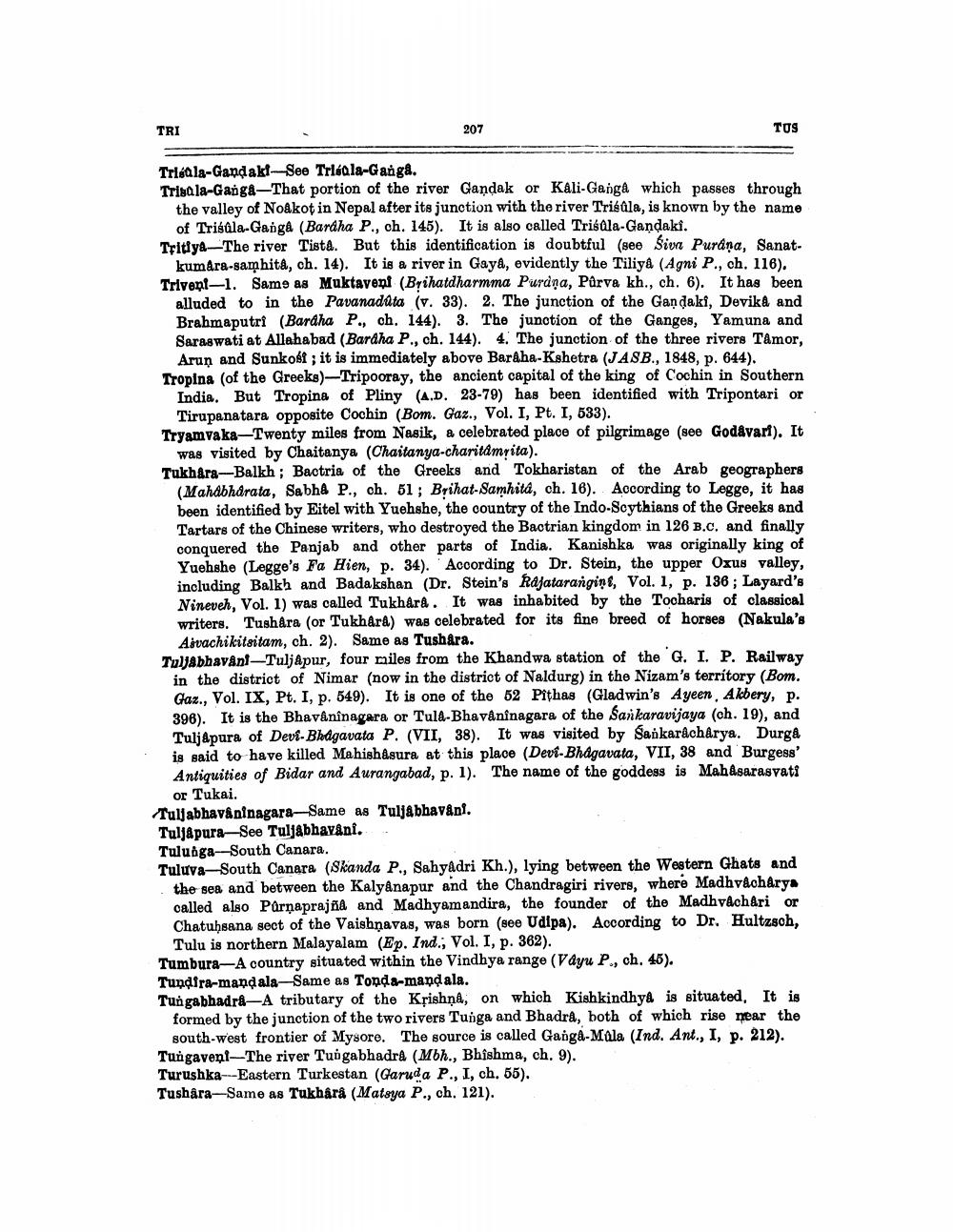________________
TRI
207
TUS
Triéala-Gandaki-See Trléala-Ganga. Trisala-Ganga-That portion of the river Gandak or Kali-Ganga which passes through the valley of Noâkot in Nepal after its junction with the river Trisûla, is known by the name of Trisula-Ganga (Bardha P., ch. 145). It is also called Trisûla-Gandaki. Tritiya The river Tista. But this identification is doubtful (see Siva Purána, Sanatkumara-samhita, ch. 14). It is a river in Gaya, evidently the Tiliya (Agni P., ch. 116). Triveni-1. Same as Muktaveni (Brihatdharmma Purana, Purva kh., ch. 6). It has been alluded to in the Pavanadûta (v. 33). 2. The junction of the Gandaki, Devika and Brahmaputri (Bardha P., ch. 144). 3. The junction of the Ganges, Yamuna and Saraswati at Allahabad (Bardha P., ch. 144). 4. The junction of the three rivers Tâmor, Arun and Sunkost; it is immediately above Barâha-Kshetra (JASB., 1848, p. 644). Tropina (of the Greeks)-Tripooray, the ancient capital of the king of Cochin in Southern India. But Tropina of Pliny (A.D. 23-79) has been identified with Tripontari or Tirupanatara opposite Cochin (Bom. Gaz., Vol. I, Pt. I, 533).
Tryamvaka-Twenty miles from Nasik, a celebrated place of pilgrimage (see Godavari). It was visited by Chaitanya (Chaitanya-charitamṛita).
Tukhara-Balkh; Bactria of the Greeks and Tokharistan of the Arab geographers (Mahabharata, Sabha P., ch. 51; Brihat-Samhita, ch. 16). According to Legge, it has been identified by Eitel with Yuehshe, the country of the Indo-Scythians of the Greeks and Tartars of the Chinese writers, who destroyed the Bactrian kingdom in 126 B.C. and finally conquered the Panjab and other parts of India. Kanishka was originally king of Yuehshe (Legge's Fa Hien, p. 34). According to Dr. Stein, the upper Oxus valley, including Balkh and Badakshan (Dr. Stein's Rajatarangint, Vol. 1, p. 136; Layard's Nineveh, Vol. 1) was called Tukhârâ. It was inhabited by the Tocharis of classical writers. Tushara (or Tukhârâ) was celebrated for its fine breed of horses (Nakula's Aivachikitsitam, ch. 2). Same as Tushara.
Tuljabhavani-Tuljapur, four miles from the Khandwa station of the G. I. P. Railway in the district of Nimar (now in the district of Naldurg) in the Nizam's territory (Bom. Gaz., Vol. IX, Pt. I, p. 549). It is one of the 52 Pithas (Gladwin's Ayeen, Akbery, p. 396). It is the Bhavânînagara or Tula-Bhavânînagara of the Sankaravijaya (ch. 19), and Tuljapura of Devi-Bhagavata P. (VII, 38). It was visited by Sankaracharya. Durga is said to have killed Mahishasura at this place (Devi-Bhagavata, VII, 38 and Burgess' Antiquities of Bidar and Aurangabad, p. 1). The name of the goddess is Mahasarasvati
or Tukai.
Tuljabhavaninagara-Same as Tuljabhavani. Tuljapura See Tuljabhavani.
Tulunga-South Canara.
Tuluva-South Canara (Skanda P., Sahyadri Kh.), lying between the Western Ghats and the sea and between the Kalyânapur and the Chandragiri rivers, where Madhvacharya called also Párnaprajña and Madhyamandira, the founder of the Madhvachari or Chatuḥsana sect of the Vaishnavas, was born (see Udipa). According to Dr. Hultzsch, Tulu is northern Malayalam (Ep. Ind., Vol. I, p. 362).
Tumbura-A country situated within the Vindhya range (Vayu P., ch. 45). Tundira-mandala-Same as Tonda-mandala.
Tungabhadra-A tributary of the Krishna, on which Kishkindhya is situated. It is formed by the junction of the two rivers Tunga and Bhadra, both of which rise near the south-west frontier of Mysore. The source is called Ganga-Mala (Ind. Ant., I, p. 212). Tungavent-The river Tuigabhadra (Mbh., Bhishma, ch. 9). Turushka---Eastern Turkestan (Garuda P., I, ch. 55). Tushara Same as Tukhârâ (Matsya P., ch. 121).




